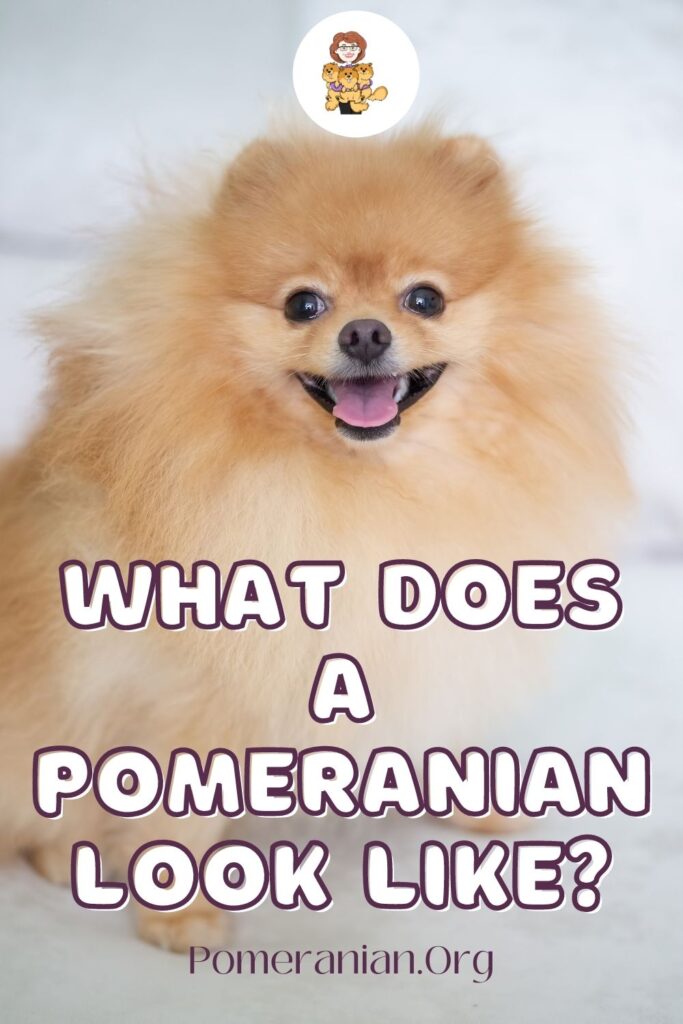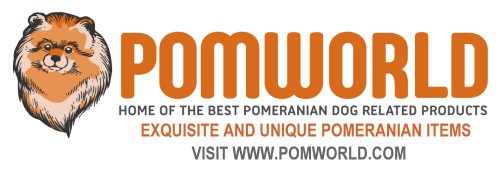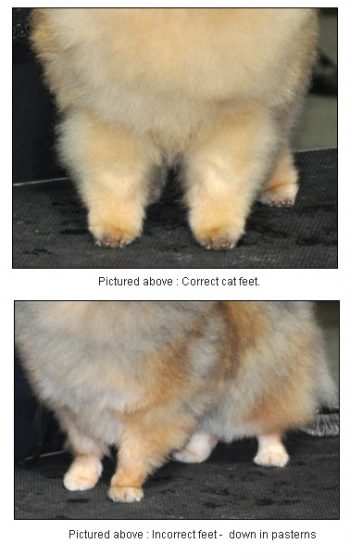Last Updated on 28/04/2024 by Denise Leo. Post first published on April 28, 2024.
What sets a Pomeranian apart? This seemingly simple question unravels a fascinating tapestry of history and endearing traits, making it one of the most adored small dog breeds. Endowed with a thick double coat and almond-shaped eyes, Pomeranians, as recognized by the American Kennel Club, are a delightful contradiction of compact size and bold personalities.
Once the favored companions of royalty, with Queen Victoria and Queen Charlotte among their notable admirers, Pomeranians carry a regal air despite their small stature. Their physical traits are just the beginning- their affectionate nature and lively spirit make them adaptable to various living situations as long as they receive regular exercise to maintain their happiness and health. Let’s delve into the unique appearance and personality traits that make this breed captivating.
The Pomeranian is a small size toy dog that weighs between 3 and 7 lbs. Some breed standards describe its head as having a fox-like expression, while others describe it as foxy in outline with small erect ears.
This dog breed has a thick, fluffy coat in various colors, including white, brown, orange, and black. When fully grown, this small dog usually measures 8 to 11 inches tall at the shoulder. The tail is covered in long hair and carried over its back.
If you want to be a Pomeranian owner, here are some things you should know about this breed. The first thing is the size and weight of these dogs. They’re small and usually weigh less than 7 pounds when fully grown.
Pomeranians can easily live in apartments or other smaller homes as long as their family provides plenty of exercise outside on walks, which we recommend at least 1 for 30 minutes per day if possible.
These active little fellows also need grooming regularly (like once every two weeks), so ensure your home has enough space for all those tools like hair dryers, combs, brushes, etc.
Luckily, this breed sheds little, so you don’t need to worry about getting pet hair everywhere!
We must know where they come from to understand the purebred Pomeranian dog truly.
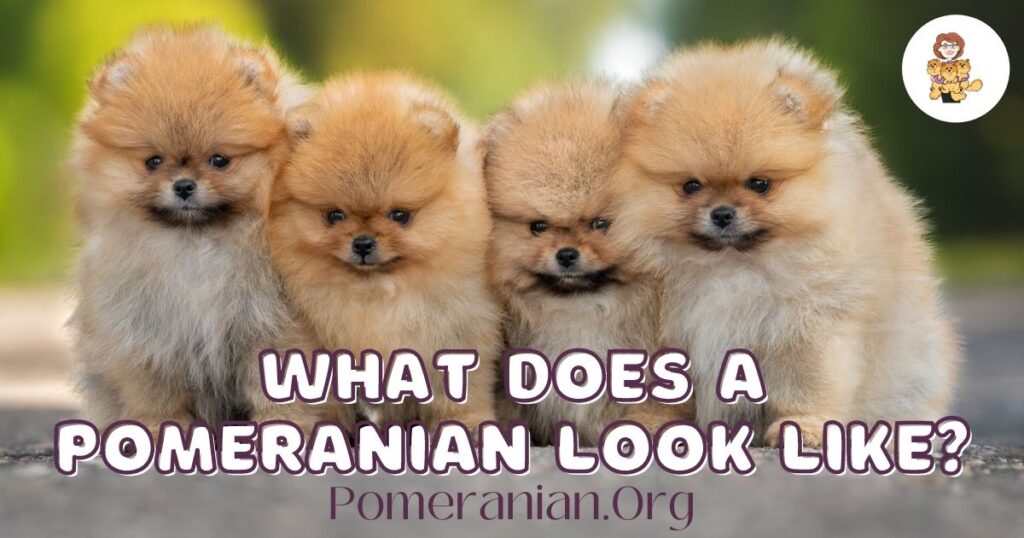
Pomeranian Origin
The Pomeranian originated in the Arctic region. While a Pom is a small dog, its history is long. The Pomeranian’s ancestors were well-suited to survive in cold habitats.
Their ancestors were bred for work and evolved to adapt to living in extremely cold climates. Today’s Pomeranians are bred and built to be loved and adored but should still retain the features of their ancestors.
The term form follows function, which also applies to the Pomeranian Dog. For the ancestors of the modern Pomeranian to survive in their habitat, northern Europe, these early spitz dogs evolved with certain features that enabled their survival in minus 35-degree temperatures.
What Does a Pomeranian Look Like?
Let us have a close look at what a Pomeranian looks like. The Pomeranian looks are explained with drawings and pictures. The purebred Pomeranian is a Spitz breed that developed characteristics necessary for survival in the harsh arctic climate.
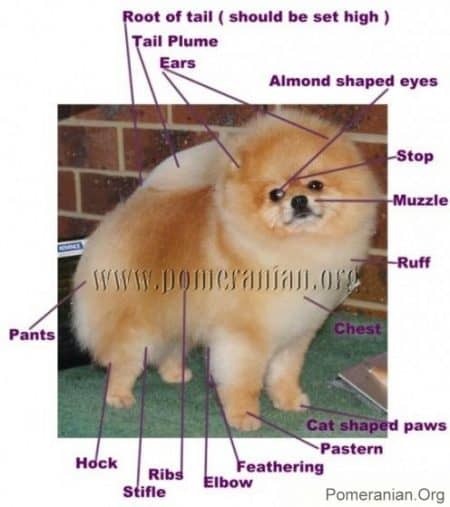
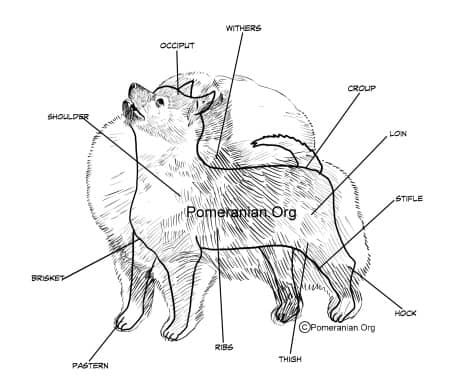
General Appearance:
The Pomeranian is a small, compact, dainty dog. He displays great glamour with his crowning glory- a dense, double coat of long, harsh, standoff guard hairs and a soft woolly undercoat. A Pomeranian has a short-coupled solid body, fine-boned, short neck, and neat, compact cat-like feet. The Pomeranian should move soundly with grace and style.
Why do Pomeranians Have a Dense Double Coat?
Pomeranians have a dense double coat to protect them from the elements. This coat helps protect their bodies and keeps them warm in cold environments or cool when they’re out in hot weather conditions.
The Pomeranian’s outer coat is straight and puffy. The dense, soft, fluffy undercoat holds it off his body and insulates in extremely cold and warm weather. The Pomeranian has short hair on its face.
What Coat Colors Do Pomeranians Come In?
The Pomeranian can be born black, brown, or cream, but the most common color is orange.
Pomeranian puppy dog colors include Beaver, Black, Blue, Brown or Chocolate, Cream, Lavender, Orange, Red, Sable Pomeranians, White, Black and Tan, Brown and Tan, Blue and Tan, Brindle, Parti colors, and Merle Pomeranians.
Average Pomeranian Weight:
The Pomeranian ideally weighs 4 to 5 pounds (1.8 to 2.5 kg), but its average size may be between 3 and 7 pounds. The female Pomeranian is preferred to be a little larger than the male Pomeranian dog.
At What Age Do Pomeranians Stop Growing?
Pomeranian puppies usually stop growing around their first birthday, but they can continue to grow for another six months.
A Pom dog is officially classed as a Pomeranian adult at 12 months of age. Some Pomeranians finish growing at one year, while other Pom dogs may not reach Pomeranian adult size until about 18 months.
Pomeranian Head:

This Pomeranian head is full of character. Its eyes are bright and expressive. A correct-shaped Pomeranian head is an essential part of the breed.
A correct Pomeranian head should be wide behind the jaw and come gradually to a fine muzzle. A lengthy muzzle results in losing the essential wedge, and the Pomeranian will have a shepherd-like look. If the jaw is too short, the Pomeranian will possess a muzzle like a Chihuahua.
The skull should not be round and domed in shape. Pomeranians with abundant head coat may often give the illusion of having a rounder-shaped head than desired. Run your fingers over the Pomeranian’s skull to determine the exact head shape if in doubt. The Pomeranian’s head must have a moderate stop.
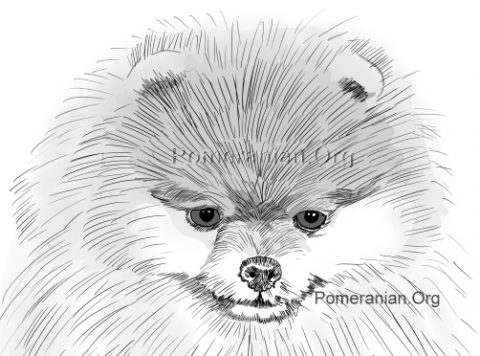
As a standard guideline, the tip of the nose to the stop and from the stop to the back of the head will measure 1:2 in most Pomeranians.
Pomeranian Ears:
Pomeranian ears are small and pointy. The ears must be small and well-positioned (not set too low down). I have never seen a Pomeranian with ears too small. Usually, the problem is the ears are either set too wide apart, too large, or both.
Why Do Pomeranians Have Small Ears?
The breed standard calls for small ears in the Pomeranian dog. This is because Pomeranians originated from parts of the Northern Hemisphere, which experiences temperatures as low as minus 30 degrees Celsius during winter.
Poms have small ears because they need to survive in cold habitats and have low volume-to-surface area ratios. Pomeranian ancestors had to conserve every bit of heat possible while they fought to survive the harsh Arctic winter months.
Pomeranian Eyes:
The Pomeranian eye color should be dark. Pomeranian eyes should be medium-sized and, most importantly, almond-shaped. Incorrect eye shape and that important Pomeranian expression is lost.
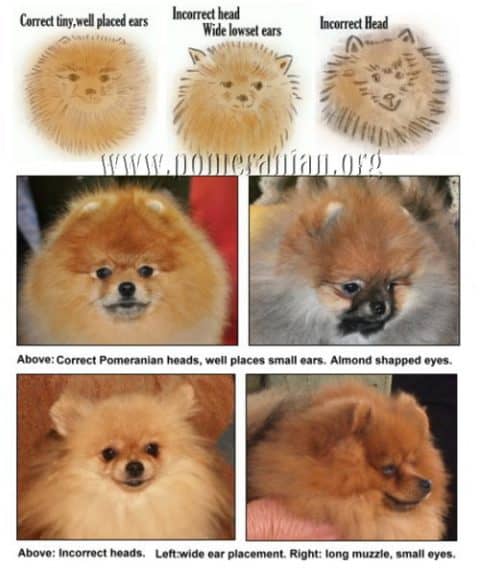
Pomeranian Teeth:
How many teeth do Pomeranians have? Puppies have 28 temporary teeth, which erupt at 3 to 4 weeks of age in most toy breeds. Poms should have 42 permanent teeth by the time they are 6 to 8 months of age.
The Pomeranian is required to have a scissor bite with the top incisors slightly in front of the bottom ones.
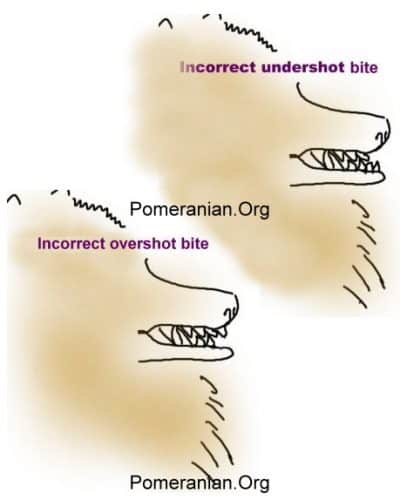
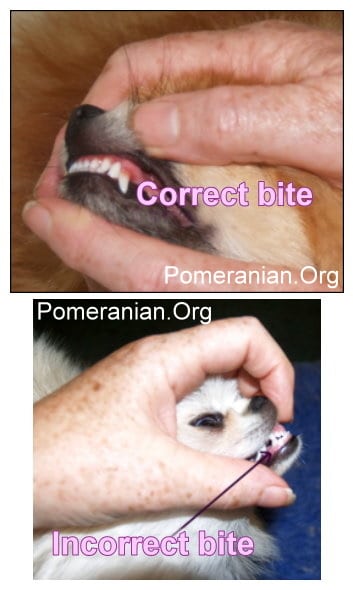
The Pomeranian Breed Standard on the bite “Bite-scissors, one tooth out of alignment is acceptable. “ Details on Pomeranian teeth problems and how to clean Pomeranian teeth.
Pomeranian Tail:
Pictured above: Examples of Pomeranian dog tails.
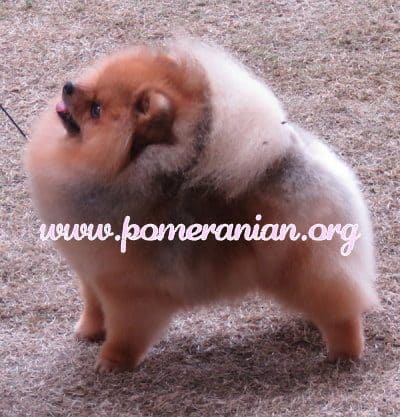
The Pomeranian tail, or plume, is a unique characteristic of the breed. It is profusely covered with long, harsh, straight hair and should be carried high and flat over the back.
The tail hair spreads out in a fan shape. Buttocks are well behind the root of the tail. If the tail is set high on the end of the backbone, it should not feel like a hard bone pressing into the palm when the palm is placed flat against the tail root.
If the tail root has a twist to the set, the tail will not lie flat but will fall over to one side, no matter how high the set, with the plume. A proper high tail set has no feel of boniness.
Why do Pomeranians Have Tails That Curl Over Their Backs?
Most of the tails of spitz-type northern dog breeds (e.g., Alaskan Malamute, Husky, Chow Chow) and Pomeranians curl over their backs. This breed feature helped warm their ancestors’ faces when they curled up to sleep in cold climates.
A Low Tail-Set Spoils The Outline Of The Pomeranian
Pom tails should not be curled or fall to one side. If the tail is set low, the bone will press into the palm when the test is made, and the root can be seen to protrude outward and upwards instead of disappearing into a flat plume up the back.
An extremely low tail set will cause the tail to circle upward in a “squirrel” tail. The tail should not be curled or fall to one side. A low tail set spoils the outline of the Pomeranian.
Pomeranian tails that are tightly curled or even kinked are a fault. Judges can be observed running fingers along with Pomeranian tails during dog show examinations.
Pomeranian puppies may inadvertently damage their tail during rough play with other pups, so care must be taken not to allow any rough play with your Pup.
Pomeranian Movement:
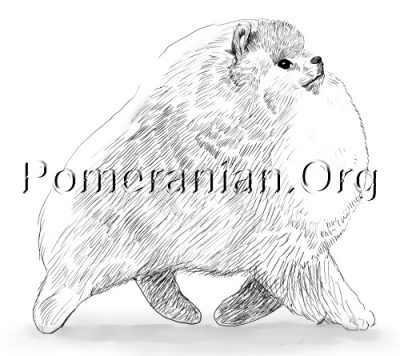
Pomeranian Fronts:
Correct and Incorrect Fronts and Pomeranian Action:
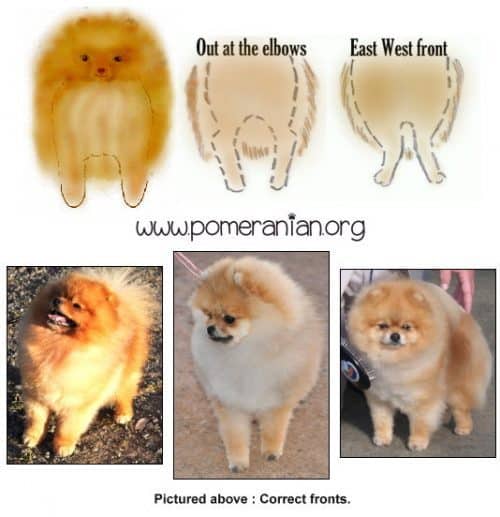
High stepping, paddling in the front, and high kicking rear legs are incorrect. Single tracking, very close or weaving front or back movement usually indicates a lack of body and is incorrect.
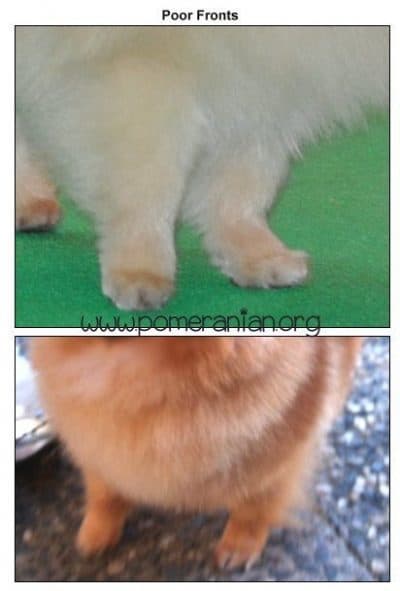
Pomeranian Front Movement:
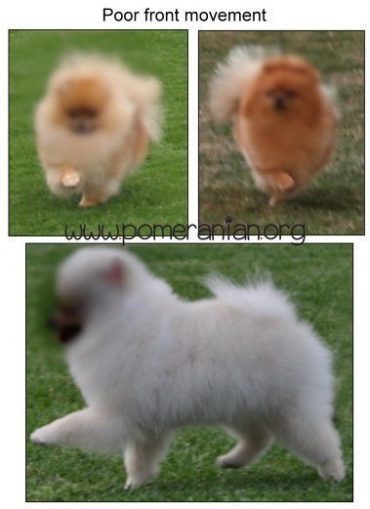
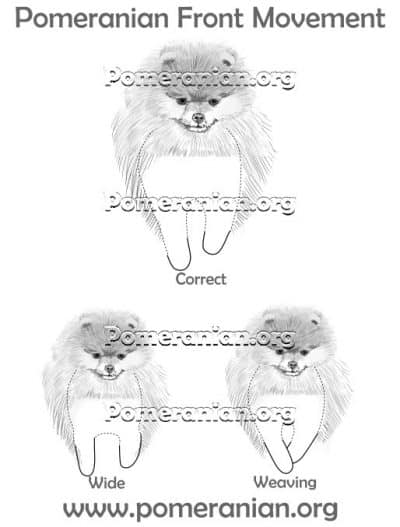
Pomeranian Hindquarters:
Angulation of the hindquarters must balance with front angulation. Viewed from behind, the pom’s legs are straight and parallel.
Viewed from the side, his buttocks are well behind the base of the tail. Hocks are perpendicular to the ground.
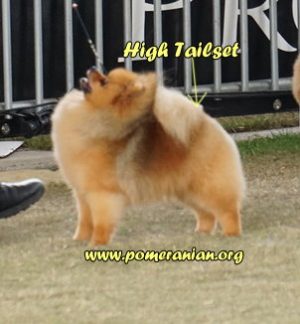
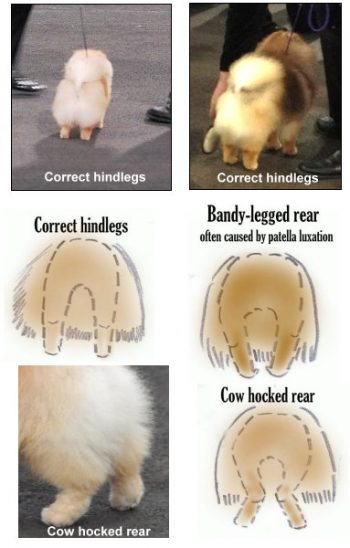
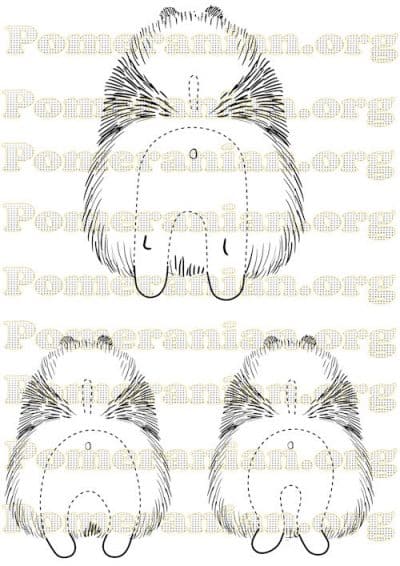
Pomeranian Rear Movement:
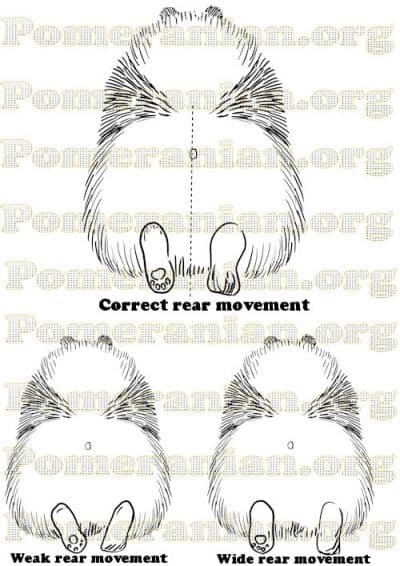
Pomeranian Feet:
A Pomeranian’s feet must be small, compact and resemble a cat’s paw with strong and straight pasterns. The feet are well arched, compact, and turn neither in nor out. He stands well up on his toes. Long, thin feet with spreading toes or down on pasterns are undesirable. When trimmed, the feet should look like an extension of the legs with only a small definition.
Why do Pomeranian Paws Resemble Cat Paws?
Pomeranian paws needed to be small and compact to enable the ancestors of the present-day Pomeranian easy movement across snow-covered landscapes. A dog with flat feet would have had difficulty moving across the type of lands inhabited by the Pomeranian’s ancestors.
Pomeranian Temperament:
The Pomeranian’s personality makes this dog a delightful family member. Although he may now come packaged in an extremely small parcel, he has not forgotten his heritage. Pomeranian behavior characteristics can be similar to those of an enormously large husky dog.
Pomeranians, as pets, are loyal and devoted. Other Pomeranian traits include loving, mischievous, affectionate, and incredibly energetic.
Health Issues
Despite their small stature, Pomeranians can encounter various health problems that potential owners should be aware of. One common issue is patellar luxation, a condition in which the kneecap dislocates, which can cause discomfort and affect the dog’s mobility.
Another significant concern is weight gain; slight weight increases can impact these little dogs’ overall health and well-being due to their small size. Keeping a balanced diet and consistent exercise is important to prevent obesity and its related health risks.
Responsible breeders play an important role in minimizing these health problems by adhering to breeding standards that promote genetic health. They also ensure that Pomeranians receive the proper care from the outset, which is critical in preventing severe health issues later on.
Coat issues, for instance, can become problematic if not managed properly from a young age. Regular grooming and care of their luxurious coats can prevent matting and skin infections, contributing to these charming dogs’ overall health and happiness.
Exercise Requirements
Despite their tiny size, Pomeranians have exercise needs that might surprise many pet parents, especially those accustomed to numerous small dogs with lower activity levels. According to the AKC breed standard, Pomeranians are lively and spirited, often displaying higher energy levels than one might expect from such small dogs.
This energy needs to be channeled through physical and mental activities to keep them from developing behaviors like separation anxiety or excessive barking. Short walks are typically sufficient to meet their physical exercise requirements, but these should be supplemented with playtime and training to ensure they remain engaged and happy.
Additionally, pet parents should be mindful of cold weather, as Pomeranians can be sensitive to lower temperatures due to their smaller body size.
For Pomeranians, mental stimulation is just as crucial as physical exercise. Such mental engagement can help mitigate potential behavior issues and provide the stimulation these intelligent dogs crave. Activities like puzzle toys, learning new tricks, or even agility training can offer the mental exercise that tiny pups like Pomeranians need.
This aspect of their care is particularly important for novice dog owners, who may need to realize just how much stimulation their new furry friend requires. Adequate exercise and mental engagement keep adult Pomeranians healthy and contribute significantly to shaping a well-rounded and well-behaved dog.
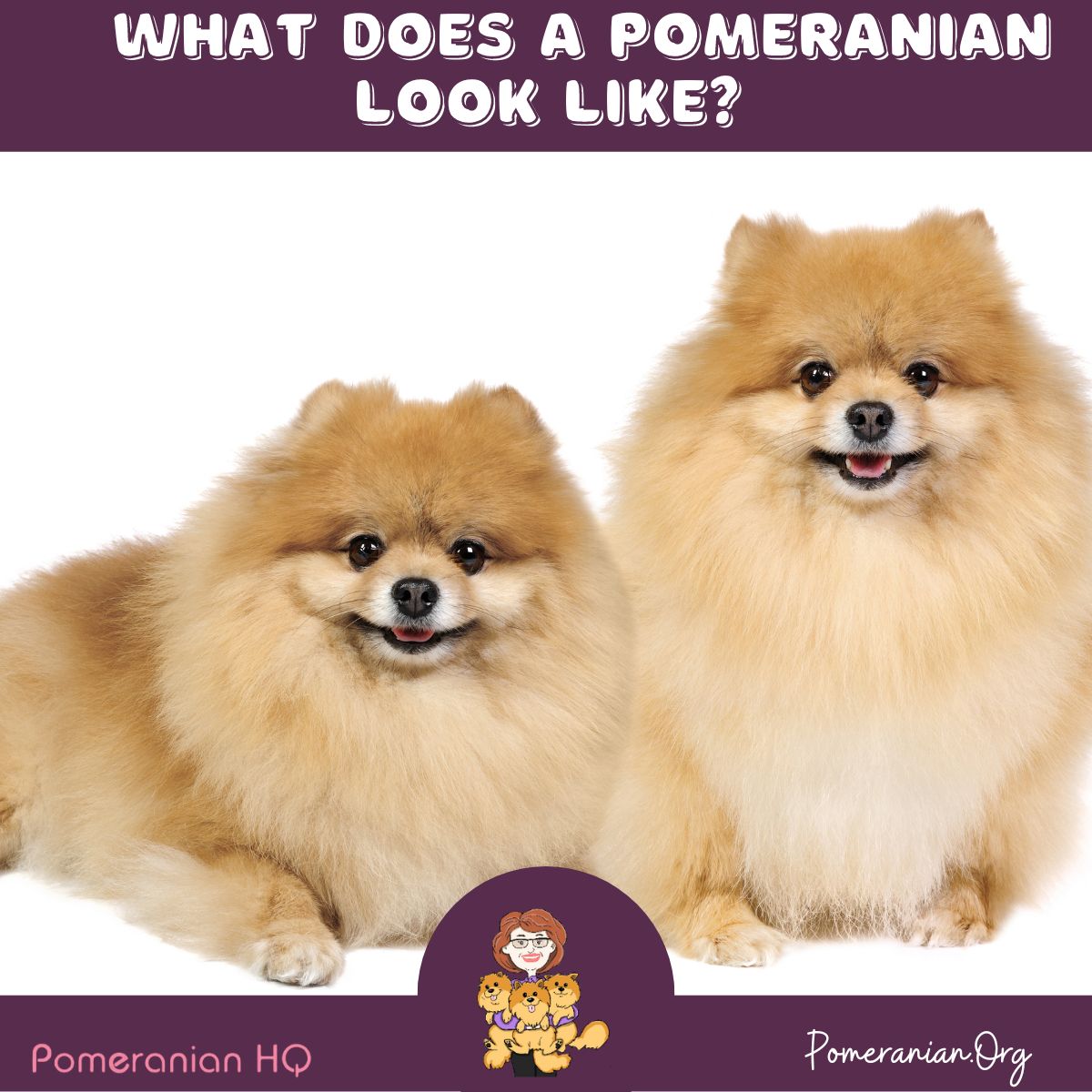
Conclusion: What Does a Pomeranian Dog Look Like?
In conclusion, the Pomeranian is a quintessential example of a small dog breed with a big personality. Known for their fox-like face and fluffy double coat, which can range from white to reddish-brown among different colors, Pomeranians are often styled with a teddy bear cut that enhances their adorable, bear-like appearance.
Despite their smaller size, Pomeranians are high-energy and spirited animals. These tiny dogs thrive in environments where they can receive much attention and interaction, making them ideal companions for families with small children or someone looking for a lap dog.
Understanding the unique needs of Pomeranians is crucial for maintaining their well-being. These sensitive dogs may not do well in loud environments or under high temperatures, suggesting a cooler, quieter setting would suit them better. Given their popularity, it’s common knowledge that these tiny dogs pack a vibrant spirit into a small package.
The American Pomeranian Club and other reputable breeders emphasize the importance of additional training and socialization from a young age to ensure these dogs develop a happy temperament. Whether cuddled on a lap or bouncing around in the yard, a well-cared-for Pomeranian is a happy pup, reflecting the joy and dynamic nature of one of the most beloved dog breeds in the United States and beyond.
This aspect of their care is particularly important for novice dog owners, who may need to realize just how much stimulation their new furry friend requires. Adequate exercise and mental engagement keep adult Pomeranians healthy and contribute significantly to shaping a well-rounded and well-behaved dog.
Copyright Pomeranian.org. All Rights Reserved.
References and Further Reading:
Official Standard of the Pomeranian (AKC). American Kennel Club, 2011.
English Kennel Club Pomeranian Breed Standard, 2017.
Denise Leo, The Pomeranian Handbook.
